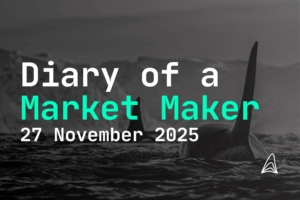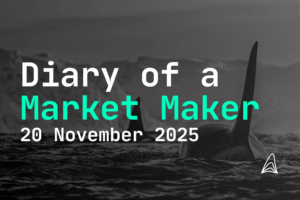
Crypto Market Maker Worst Nightmares
- Jakob Brezigar
- Last updated: 4.May 2024
- Reading time: 4 min
The role of a crypto market maker is a high-stakes game, where the balance between maintaining liquidity, ensuring fair price setting, and managing personal risk is constantly challenged by an array of factors. This article addresses the multifaceted “nightmares” that crypto market makers encounter, enriched with additional problem-specific insights.

Table of Contents
What are the main risks for crypto market makers?
Crypto market makers primarily face risks from market volatility, technological failures, regulatory changes, and market manipulation.
How does market volatility affect crypto market makers?
Volatility can drastically alter liquidity and pricing, requiring market makers to quickly adjust their strategies to maintain stability and profitability.
Why is the VPIN metric important for market makers?
The VPIN metric helps market makers assess and manage the risks associated with high-frequency trading by evaluating market toxicity.
Key Takeaways - Crypto Market Maker Worst Nightmares:
- Market makers face severe risks from high market volatility, impacting liquidity and pricing.
- Technological failures in trading infrastructure can lead to significant financial losses.
- Regulatory landscapes are rapidly evolving, demanding constant compliance adjustments.
- Market manipulation poses ongoing challenges for maintaining fair trading environments.
- VPIN metric crucial for managing risks associated with high-frequency trading.
Market Volatility: Navigating the Unpredictable Waves
Market volatility is one of the the most palpable of the crypto market maker worst nightmares actually faced by the market makers. The crypto market is notoriously volatile, with prices capable of swinging wildly based on news, market sentiment, or even social media posts from influential figures. This environment demands that market makers employ sophisticated algorithms and real-time data analytics to predict and react to market movements swiftly. The high frequency of trades and the need for instant decision-making compound the stress and complexity of maintaining stability and profitability under volatile conditions.
Technological Failures: System Downtimes and Glitches
The reliance on advanced technological systems to execute trades seamlessly places market makers at the mercy of their IT infrastructure. System downtimes and glitches are not just minor inconveniences but major crises that can lead to missed opportunities and significant financial losses.
These technological failures can occur due to a range of issues, from hardware malfunctions and software bugs to cybersecurity breaches. The rapid response required to mitigate these issues is crucial in preventing a temporary glitch from becoming a full-blown financial disaster. Annually, businesses (generally speaking, not crypto specific only) face over $26.5 billion in revenue losses due to IT outages, with each business losing roughly $150,000.
Downtime in Crypto
In the crypto world such outages very likely result in much greater numbers. One survey highlights that despite the severe financial risks, 56% of North American and 30% of European enterprises lack a comprehensive disaster recovery plan. On average, businesses experience 14 hours of IT downtime each year, which severely damages their reputation and customer relations.
The data suggests a strong need for a hybrid IT infrastructure to enhance data security and mitigate risks associated with IT failures. The reputation damages are especially notable in the world of crypto, where both crypto platforms as well as the crypto market makers quickly get damage in reputation in such cases.

Regulatory Changes and Compliance Nightmares
Crypto market makers operate in a regulatory grey area that is continuously evolving. Each country may have different rules and regulations affecting how crypto markets operate, and changes can come with little warning. Staying ahead of these regulatory changes and ensuring compliance is crucial to avoid hefty fines and legal challenges. The complexity is further increased by the need to monitor and adapt to multiple jurisdictions, making compliance a significant operational burden.
Some Regulatory Changes in 2023
In 2023, the regulatory framework for cryptocurrencies and digital assets underwent significant developments. Key U.S. regulators like the SEC and CFTC expressed their intentions to obtain expanded oversight, especially concerning stablecoins, to better align with securities and commodities classifications.
The introduction of a federal definition for “digital assets” through the Infrastructure Investment and Jobs Act brought further clarity, while IRS reporting requirements set for cryptocurrencies aimed to enhance transparency starting in 2023.
Additionally, the establishment of the DOJ’s National Cryptocurrency Enforcement Team marked a pivotal step in tackling criminal activities associated with cryptocurrencies. These measures reflect a more structured and tightly monitored approach to digital asset regulation and compliance heading into 2024.
The Risk of Market Manipulation
The decentralized and sometimes opaque nature of crypto markets opens the door to various forms of market manipulation, such as pump-and-dump schemes and spoofing. These deceptive practices can artificially inflate or deflate prices, leading to market distortions.
Market makers must be vigilant and have systems in place to detect and mitigate the effects of manipulation, protecting their operations and maintaining trust in the marketplace. This is also one of the strongest cases with our in-house built bots which have numerous protective measures built-in in order to safeguard the assets to the highest degree.
Toxic Flow (Adverse Selection) Problem
Adverse selection, or toxic flow, occurs when market makers provide liquidity to traders who have information advantages that can be used to exploit these market makers’ pricing. This situation is akin to betting in a game where the other player has an unfair advantage. Strategies to mitigate adverse selection include developing predictive models that adjust offers based on the likelihood of adverse selection and setting wider spreads for trades that carry a higher risk of information asymmetry.
One method that assesses the Volume-Synchronized Probability of Informed Trading, or VPIN, which serves as a key indicator of market toxicity and is updated throughout the trading day to keep pace with real-time market conditions.
This tool is invaluable for managing risks in high-frequency trading, helping both market makers and traders respond to shifts in liquidity and potential large price movements. It shows promise for predicting volatility induced by market toxicity and could be further developed to optimize trading strategies and exchange resources dynamically.
Dealing with Fraud and Security Threats
The digital and global nature of cryptocurrency trading makes market makers prime targets for fraud and security threats. These can range from hacking and phishing to more sophisticated forms of cyberattacks that can compromise entire exchanges. Robust security protocols, continuous monitoring, and advanced cybersecurity measures are essential to protect both the market makers’ assets and their clients’ interests.

The Impact of Low Liquidity on Market Making
In markets where liquidity is low, market makers play a critical role in facilitating trades by providing the needed liquidity. However, this comes with the risk of significant price impact when large orders are executed. Managing these risks requires sophisticated strategies to modulate the order flow and minimize the market impact, ensuring that the market remains efficient and prices do not fluctuate wildly due to the market makers’ own actions.
Financial Losses Due to Rapid Market Shifts
Rapid shifts in the market can lead to substantial financial losses for market makers who cannot adjust quickly enough. These shifts might be triggered by macroeconomic changes, geopolitical events, or significant industry developments. Maintaining a diversified portfolio and having contingency strategies in place are essential practices to cushion against potential losses and ensure long-term viability.
The Challenges of Maintaining Competitive Spreads
To attract and retain traders for the exchanges, market makers must offer competitive spreads that are neither too wide (which may deter traders due to higher costs) nor too narrow (which can diminish the market makers’ profit margins). This balancing act requires constant market analysis and adjustment of pricing strategies to align with current market conditions, competitor activities, and trading volume.

The Burden of High Operational Costs
The operational costs associated with running a market-making operation are substantial. These include technological investments, personnel costs, compliance and legal fees, and the costs associated with risk management. Efficient management of these costs is crucial to maintain profitability, requiring careful budgeting, continual process optimization, and strategic planning.
Ethical Dilemmas in Market Making
Ethical dilemmas in market making often involve decisions that affect market integrity versus potential profit opportunities. Examples include how aggressively to manage order flows or the decision to stop trading in certain markets. These decisions require a careful consideration of ethical implications and the long-term health of the market versus short-term gains.
Summary
Crypto market making is a dynamic and intricate field fraught with operational and strategic challenges. The ”nightmares” outlined above underscore the multifaceted nature of this role, where technological prowess, strategic foresight, and ethical considerations must all align to navigate the risky waters of the crypto market. Embracing these challenges with robust strategies and innovative solutions, like those provided by Orcabay, market makers can not only mitigate these risks but also capitalize on the opportunities that arise in such a vibrant market.
In essence, the role of a crypto market maker, while filled with potential pitfalls, also presents numerous opportunities for innovation and profit in the rapidly evolving digital finance landscape. Effective management of the outlined risks and proactive engagement with the market’s complexities are essential for any entity looking to succeed in this high-stakes arena.
Disclaimer: The information provided in this article is for informational purposes only and does not constitute financial, investment, or other professional advice. All opinions expressed herein are solely those of the author and do not represent the views or opinions of any entity with which the author may be associated. Investing in financial markets involves risk, including the potential loss of principal. Readers should perform their own research and consult with a licensed financial advisor before making any investment decisions. Past performance is not indicative of future results.

Jakob Brezigar
Jakob, an experienced specialist in the field of cryptocurrency market making, boasts an extensive international presence. With Orcabay, he has skillfully managed major operations and deals for a wide array of global stakeholders.



